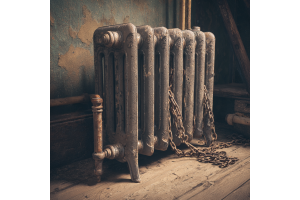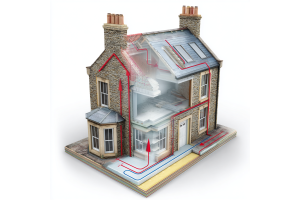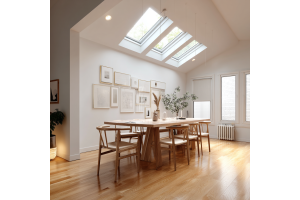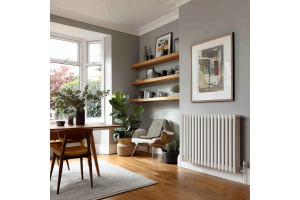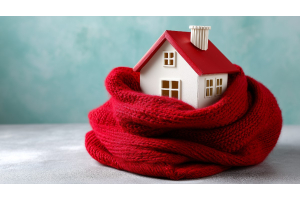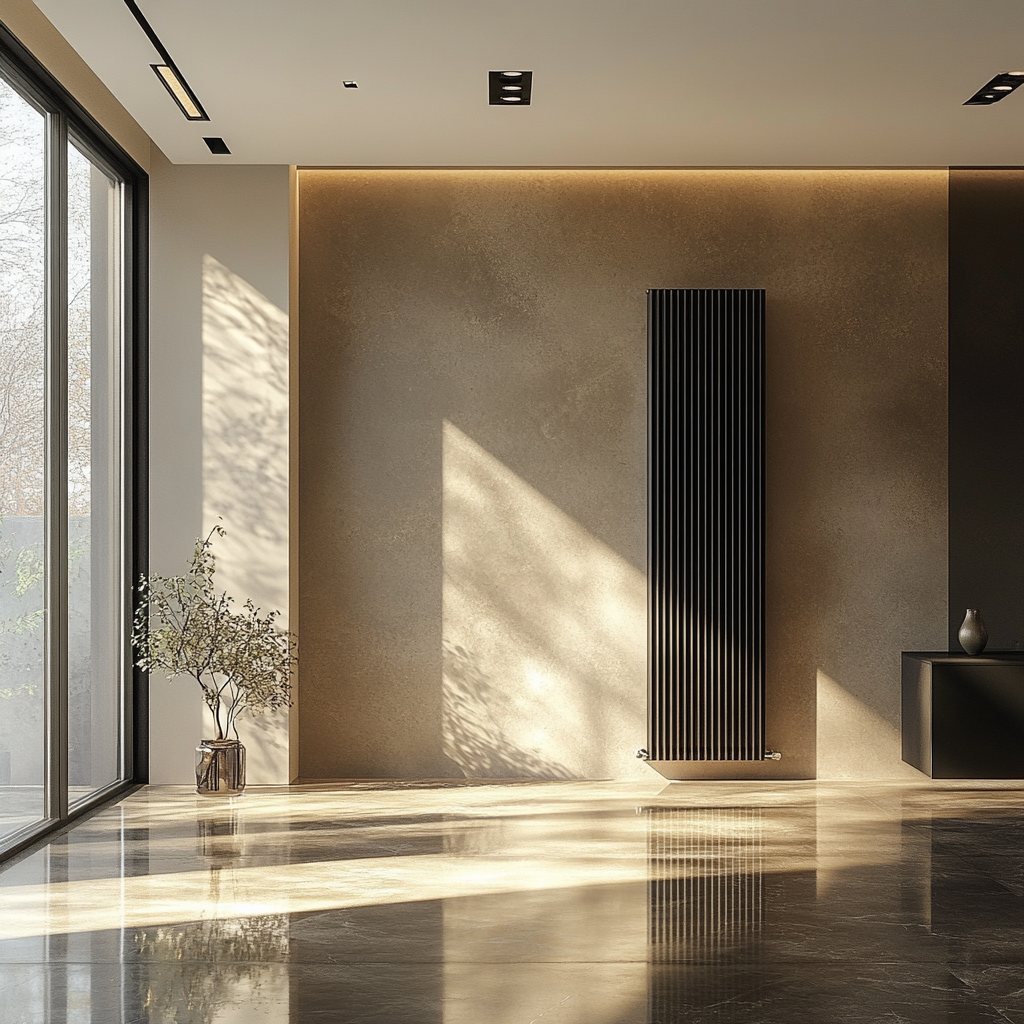
Radiators are no longer just a practical necessity for heating your home; they have evolved into stylish design elements that can enhance the aesthetic of any space. Whether you're aiming for a sleek, modern look, a vintage charm, or an industrial edge, the right radiator can serve as both a functional and decorative feature.
In this guide, we will explore how to seamlessly integrate modern and decorative radiators into your interior design, considering factors such as style, placement, materials, and colour choices to create a harmonious and efficient living space.
1. Choosing the Right Radiator Style for Your Home
Radiators come in a variety of styles, each complementing different interior design themes. When selecting a radiator, consider the existing decor and how the radiator will contribute to the overall ambiance of your space. Here are some key styles and their ideal applications:
a. Contemporary and Minimalist Interiors
For homes with a modern, minimalist aesthetic, opt for sleek and streamlined radiators with simple geometric shapes. Vertical radiators or flat-panel designs work well in contemporary spaces, offering a chic yet understated look. Slimline radiators in neutral tones like white, grey, or black blend seamlessly into modern decor, while mirrored or glass-panel radiators add a touch of sophistication and function as both heating units and reflective surfaces.
b. Classic and Traditional Interiors
If your home features classic decor with period-style elements, cast iron or column radiators can complement the timeless elegance of your space. These radiators evoke vintage charm while still providing efficient heating. Ornate designs with intricate detailing and metallic finishes like bronze, brass, or antique white can enhance the grandeur of a traditionally styled home.
c. Industrial and Loft-Style Spaces
For industrial-style interiors, exposed pipework and raw materials such as steel or aluminium radiators work well. Anthracite or black finishes add a rugged yet stylish appeal, blending seamlessly with exposed brick and concrete walls. Towel radiators with a matte or brushed steel finish can also contribute to an industrial, warehouse-inspired aesthetic.
d. Scandinavian and Minimalist Interiors
Scandinavian design favors functional, elegant, and understated decor. For this style, opt for radiators with clean lines, soft colors like pastel or off-white, and eco-friendly materials such as aluminium. A vertical radiator with a slim profile fits well in open, airy spaces, maximizing efficiency without overwhelming the decor.
e. Luxury and Designer Homes
Bespoke and designer radiators offer unique, artistic designs that make a bold statement. Sculptural radiators or models with glass, mirror, or metallic finishes can elevate a high-end interior. Some modern radiators incorporate LED lighting, digital temperature controls, or innovative geometric patterns to further enhance their aesthetic appeal.
By carefully selecting a radiator style that matches your home’s theme, you can seamlessly integrate heating into your decor while adding a stylish touch to your living space.
2. Placement Strategies for Maximum Impact
Choosing the right location for your radiator is crucial for both efficiency (https://energysavingtrust.org.uk/energy-at-home/heating-your-home/) and aesthetics. A well-placed radiator can enhance heat distribution, save space, and even become a focal point in your interior design. Here are key placement strategies to consider:
a. Feature Wall Radiators
Instead of hiding your radiator, make it a focal point by placing it on a feature wall. Designer radiators in bold colours, geometric shapes, or mirrored finishes can act as a functional piece of art. This is particularly effective in modern and luxury interiors where the radiator can double as a statement piece.
b. Vertical Radiators for Small Spaces
For compact rooms, vertical radiators provide efficient heating without taking up valuable floor space. They are ideal for hallways, kitchens, and small apartments, where wall space is limited. A tall, slim radiator can maximize warmth while maintaining a sleek aesthetic.
c. Under-the-Window Radiators
Placing radiators under windows is a classic and effective choice. This position helps distribute heat evenly while counteracting cold air entering from the window. Modern designs allow for stylish, low-profile radiators that blend seamlessly with window spaces while maintaining efficiency.
d. Room Dividers and Statement Pieces
Some modern radiators double as stylish room dividers, helping to define open-plan spaces while maintaining warmth. Freestanding or designer radiators with unique shapes and finishes can serve as sculptural elements that separate different functional areas in a large room without obstructing light or airflow.
e. Radiators Behind Furniture – Smart or Inefficient?
While placing a radiator behind furniture can sometimes save space, it is generally not recommended unless the furniture is designed to allow proper airflow. Obstructing a radiator can reduce its efficiency and limit heat circulation in the room. If space constraints require placing a radiator near furniture, opt for a wall-mounted or low-profile model with ample clearance.
By strategically placing your radiators, you can optimize heating efficiency while enhancing your home’s visual appeal, ensuring both functionality and design harmony.
3. Material and Finish Choices for Aesthetic Appeal
The material and finish of a radiator play a crucial role in both its efficiency and how well it complements your home’s decor. Here’s a more in-depth look at different material options and their benefits:
a. Stainless Steel Radiators
Stainless steel radiators are a popular choice for modern homes due to their sleek and polished finish. They are highly resistant to rust and corrosion, making them ideal for humid environments such as bathrooms and kitchens. These radiators retain heat well, ensuring efficient performance over time.
b. Aluminium Radiators
Aluminium radiators are lightweight and known for their quick heat-up times, making them an energy-efficient choice. They work particularly well in contemporary and minimalist interiors due to their modern designs and availability in various matte, brushed, or polished finishes. Their ability to distribute heat evenly ensures optimal warmth while using less energy.
c. Cast Iron Radiators
For those who appreciate classic aesthetics, cast iron radiators are an excellent option. They take longer to heat up but retain heat for extended periods, making them a cost-effective choice for traditional homes. Their intricate detailing and vintage appeal make them ideal for period properties, Victorian-style homes, or spaces with a heritage-inspired design.
d. Coloured and Custom Radiators
Modern radiators are available in a wide array of colours and finishes, allowing homeowners to match their radiator to their existing decor. Bold hues like deep blue, red, or emerald green can create a striking feature, while neutral shades like soft grey, cream, or pastel tones blend seamlessly with various interior styles.
e. Glass and Mirrored Radiators
For a truly innovative and space-enhancing option, glass or mirrored radiators are an elegant solution. These radiators not only provide warmth but also reflect light, making rooms feel more open and spacious. They are perfect for contemporary and luxury interiors, adding a sleek and high-end touch.
By carefully selecting the right material and finish for your radiators, you can ensure that they not only provide efficient heating but also contribute to the overall aesthetics of your home, creating a stylish and cohesive living space.
4. Enhancing Your Radiator with Accessories and Covers
Accessories and covers can further integrate radiators into your interior design while improving their functionality. Here are some creative ways to enhance your radiator:
a. Radiator Covers and Enclosures
If you prefer a more discreet look, radiator covers can seamlessly blend the radiator into the room’s decor. Choose a design with ventilation to ensure efficient heat distribution. Opt for wooden or metal covers that match your existing furnishings while still allowing airflow for effective heating.
b. Designer Valves and Controls
Upgrade your radiator’s appearance with stylish valve designs in chrome, brass, or matte finishes to complement your overall decor. Smart thermostatic radiator valves (TRVs) allow for better temperature control and energy efficiency, making your heating system both practical and aesthetically appealing.
c. Shelf Integration
Adding a radiator shelf above your unit not only enhances the design but also provides additional surface space for decorative items such as plants, candles, or framed artwork. This is particularly useful in kitchens and living rooms where space-saving solutions are essential.
d. Radiator Covers with Built-in Storage
Some radiator covers double as storage units, incorporating shelving or seating areas above the radiator. This is an excellent option for maximizing space in small apartments or hallways while keeping the heating element functional.
e. Reflective Panels for Improved Efficiency
To prevent heat loss through walls, installing reflective panels behind radiators can help direct warmth back into the room, making the heating system more efficient while keeping energy costs lower.
By accessorizing and customizing your radiators, you can transform them into practical yet stylish elements that enhance your overall home decor.
5. Smart Heating Technology and Radiator Efficiency
a. Smart Thermostats
Integrating smart thermostats with your radiators allows for precise temperature control, remote access, and scheduling. Brands like Nest, Hive, and Tado offer energy-efficient heating solutions that adapt to your lifestyle.
b. Thermostatic Radiator Valves (TRVs)
TRVs enable individual radiator temperature regulation, preventing unnecessary energy consumption and optimizing heating costs.
c. Zoned Heating Systems
Dividing your home into heating zones ensures warmth is distributed efficiently, avoiding overheating in unused rooms.
d. Wi-Fi-Enabled Radiators
Many modern radiators now come with Wi-Fi connectivity, allowing users to adjust settings via a smartphone app, ensuring maximum efficiency.
e. Energy-Saving Tips
Using radiator reflectors, regular maintenance, and bleeding radiators improve efficiency, reducing energy costs while keeping your home warm.
By incorporating smart heating technology, you can maximize energy efficiency, reduce costs, and maintain a comfortable, well-heated home.
Conclusion
Modern decorative radiators offer the perfect blend of functionality and aesthetics, allowing homeowners to maintain a warm and comfortable environment while enhancing their interior design. With various styles, materials, and placement options available, it is easier than ever to integrate radiators seamlessly into any decor, from classic to contemporary.
Choosing the right radiator style ensures that it complements the overall theme of your space, whether you prefer a sleek, modern look, a vintage charm, or an industrial feel. Strategic placement not only optimizes heat distribution but also transforms radiators into design focal points rather than just practical fixtures. Additionally, selecting the right materials and finishes can enhance the visual appeal while improving heating efficiency.
Accessories and smart heating technology further elevate the experience, providing greater convenience, energy savings, and customization. Features such as smart thermostats, Wi-Fi-enabled radiators, and thermostatic radiator valves allow precise temperature control, making your home more energy-efficient while reducing heating costs.
By thoughtfully selecting, positioning, and accessorizing your radiators, you can create a stylish yet functional heating solution tailored to your unique home environment. Whether you are renovating, redecorating, or building a new space, integrating modern radiators into your interior design will enhance both comfort and aesthetics, ensuring your home remains inviting and visually appealing all year round.



